The street art that expressed the world’s pain
Over the summer of 2020, a portrait recurred on city walls across the world: an image of the black American George Floyd, who was brutally suffocated to death by police officer David Chauvin on 25 May, 2020. Most of these portraits were based on Floyd’s 2016 selfie, taken from his own Facebook account; many referred to the torment of his killing, and his final words. Thousands of miles from the US, protests numerous graffiti tributes to Floyd appeared in European cities and in Asia, Africa and Australia.
More like this:
– The music movement that took on racism
– Striking images of black struggle
– The images inspired by protest
In Karachi, truck artist Haider Ali painted a portrait inscribed with English tags (‘#blacklivesmatter’) and Urdu song lyrics (“This world doesn’t belong to white or black people, it belongs to the ones with heart”); in Idlib, northwestern Syria, Floyd appeared among the war-ravaged ruins; in Nairobi, he was depicted alongside the Swahili word “haki“, meaning ‘justice’ (in a work by Kenyan artist Allan Mwangi, aka Mr Detail Seven); Palestinian artist Taqi Sbatin painted Floyd on the West Bank barrier; in Berlin’s Mauerpark, Floyd was portrayed on the wall by Dominican-born artist Eme Freethinker, alongside an array of iconic black US figures: Malcolm X, Martin Luther King, Angela Davis, Jean-Michel Basquiat and the musician Prince.
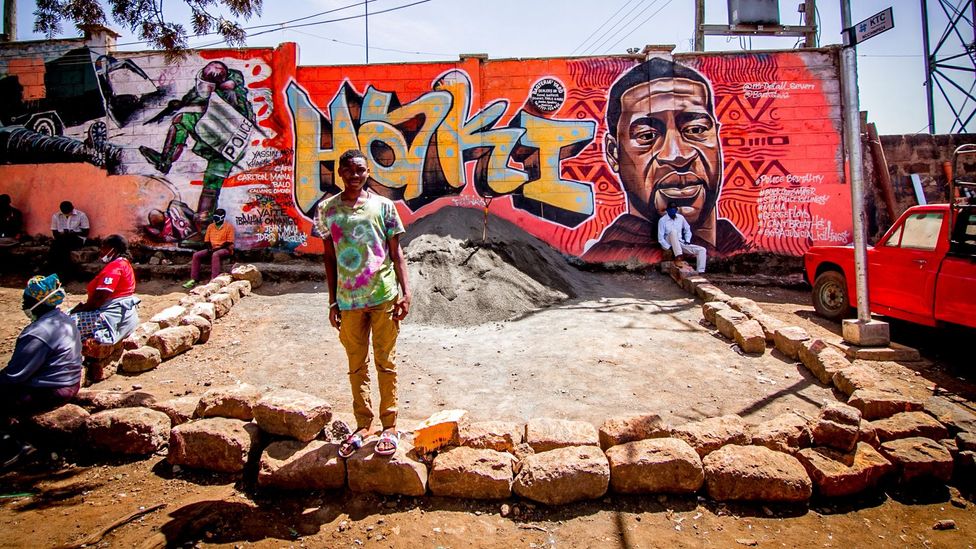
A mural in Nairobi, Kenya, by Mr Detail
These portraits are a testimony to human empathy, and the reach of the vast, multi-stranded Black Lives Matter movement. Graffiti is both an ancient form (traced back to writing on the wall in Ancient Greece and Rome) and a vital contemporary statement about society; independent graffiti and commissioned public art have also brought vivid focus to BLM. In a year when history is being emphatically questioned, and where a global pandemic has shut conventional galleries and museums, street art also highlights a diversity of vewpoints. The very public horror of Floyd’s killing (captured on videocam) lingers, but he is rarely an isolated figure; mural memorials also say the names of generations of innocent black US victims: among them, Breonna Taylor (killed by the police in her own home, 13 March, 2020); 12-year-old Tamir Rice (fatally shot by the police, 22 November, 2014); 14-year-old Emmett Till (lynched by racists, 28 August, 1955).
Graffiti has both an ephemeral quality, and an enduring power
International artists bring their own resonance; the Nairobi mural of Floyd also draws attention to accusations of police brutality in Kenya; Freethinker was adamant that his Berlin mural should honour Floyd’s life, rather than visualise his death, although he added in an interview with NPR: “I saw many, many other guys die by the police in my country, like almost for nothing. So I know how it is.” Syrian artist Aziz Asmar, who created the Idlib mural with Anis Hamdoun, told The National: “Art is a universal language. Our humanity requires us to unite with other people who are facing injustice. When we draw on the walls of destroyed buildings, we are telling the world that underneath these buildings there are people who have died or who have left their homes. It shows you that there was injustice here, just like there’s injustice in America.”
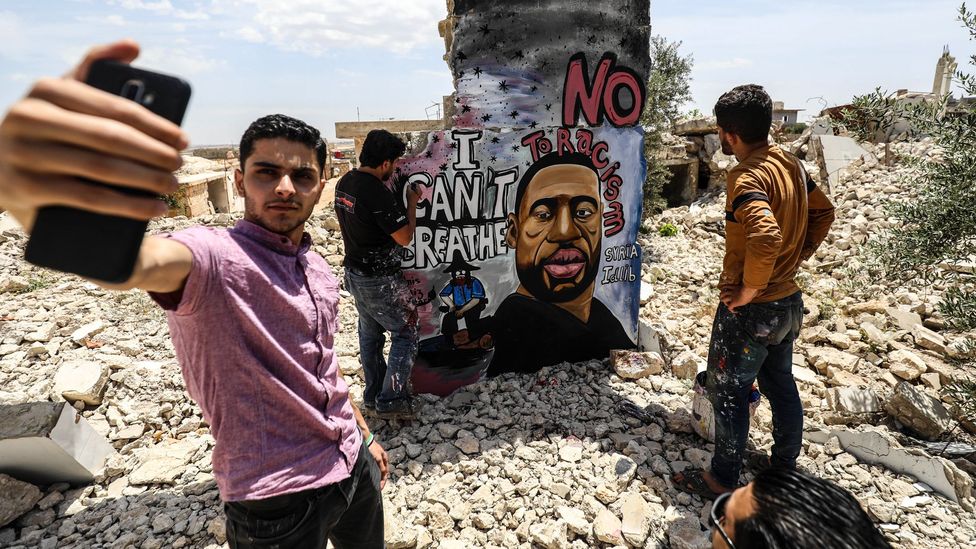
A friend of the muralist Aziz Asmar take
Graffiti has both an ephemeral quality, and an enduring power. Writing in the LA Times, academic and author Susan A Philips (whose books include The City Beneath: A Century of Los Angeles Graffiti) recently argued: “Political graffiti is a critical intervention in urban space, especially as municipalities and police attempt to shut down the streets. Even after protests have dispersed, graffiti stands as a testament to the protestors’ collective voice… The graffiti may soon be washed away, but not before it is documented, becoming part of history.”
In South Minneapolis, US, the Cup Foods convenience store, where a 911 call led to George Floyd’s police killing, is now emblazoned with memorial art. One particularly moving piece was created by local illustrator, muralist and teacher Melodee Strong; entitled Mama after Floyd’s dying plea, it depicts grieving black mothers, against a backdrop of the US flag.
“I am a mother, and when George cried out for his ‘mama’ as he was taking his last breaths, I also cried,” Strong tells BBC Culture. “That’s what we do when we are in trouble or scared, we cry out for God or our mothers. My son has been harassed and mistreated by the police. I have witnessed numerous times how the people I love have been abused by police. The anguish we feel from the fear and the experiences of those too many incidences is what I feel in the faces I painted… Even though this piece is about George Floyd, it’s more a dedication to all the mothers that have lost their child to police violence.”
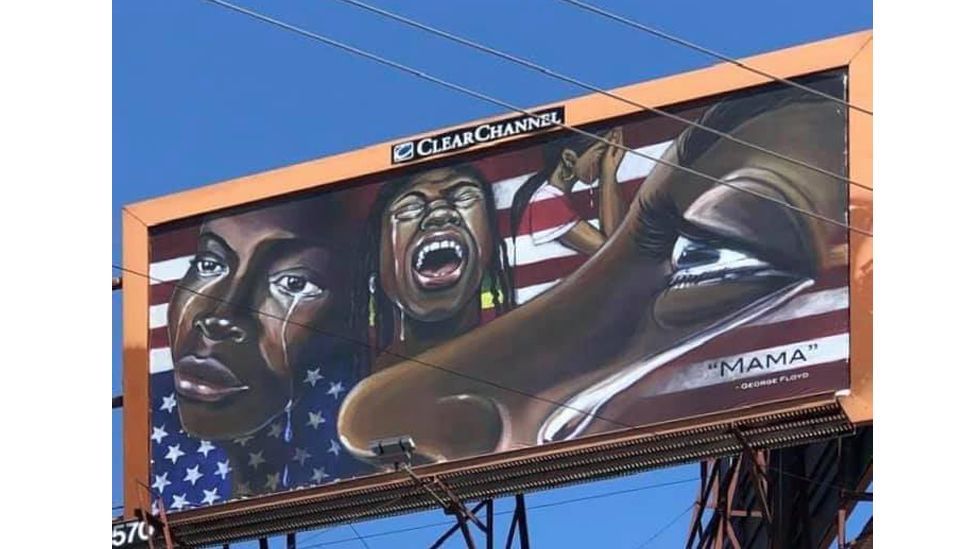
In South Minneapolis, an artwork by Melo
Social media brings these streets and statements much closer, wherever we are. Strong champions the positive force of graffiti and street murals, on local and global levels (“It’s empowering and it gives pride. The people and culture represented in these images validates a community… When it comes to activism, it’s allowing a space to have a voice, when for so long that voice has been suppressed and oppressed”). At the same time, she has made cogent points about how media-savvy artists sometimes overshadow community voices:
“I still believe this is so,” she says. “Everyone has an opinion and everyone is dealing with this in their own way. I am cool with white artists making their mark in history but I also believe we need to allow BIPOC artists a place first. So often we are cast aside, and now we are seeing a trend where companies and patrons are seeking our work; not sure if it’s ‘white guilt’ or it’s just the ‘popular thing to do’ right now, but we need to recognise that BIPOC artists have always been here, and will continue to be.”
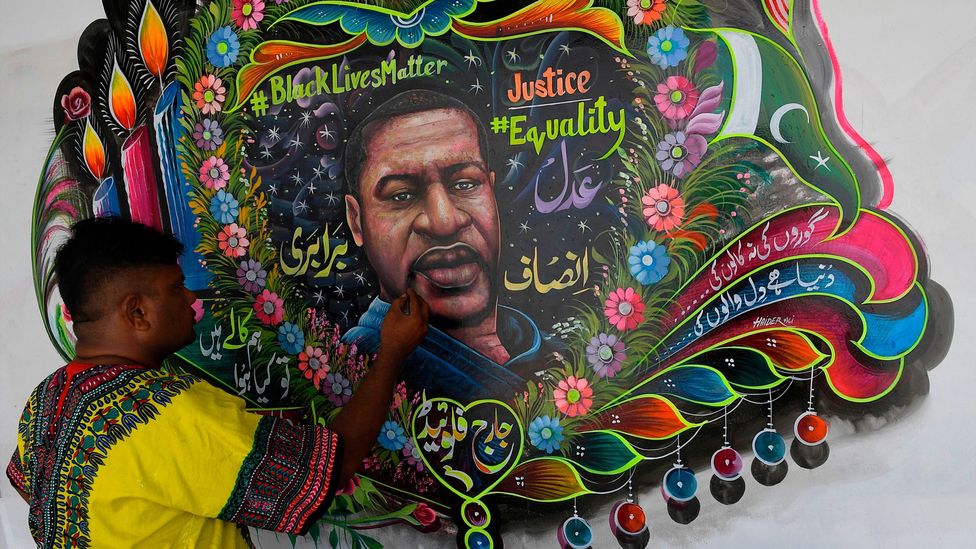
Truck artist Haider Ali puts the final touc
There is a need for lasting change, in Strong’s view: “Don’t just use us now, but rather continue to provide the platforms and the resources to empower our voices. It shouldn’t just be about satisfying a trend but actually making an effort towards real change. Including us more. And when you do, really listen. And listen to several of us. Don’t token one artist and make them the spokesperson for the whole group. We are diverse within our communities and we have a lot to say and in different ways.”
Righteous fury
There is righteous fury in BLM-inspired graffiti, and also beauty in its details: the names of great thinkers, creators and activists; the image of unity, strength and potential. Black experience cannot be encapsulated as trauma alone; its celebratory, inspirational range must be wholly acknowledged. There are also significant contemporary artists who are not specifically linked to BLM, but whose works embody its energy. Take the empowering, grand-scale, yet immediately relatable portraits painted by the London-based artist and educator Dreph (aka Neequaye Dsane), which have appeared around the world, including residencies in Brazil and Cape Verde, and artwork in the Accra neighbourhood where his father grew up.
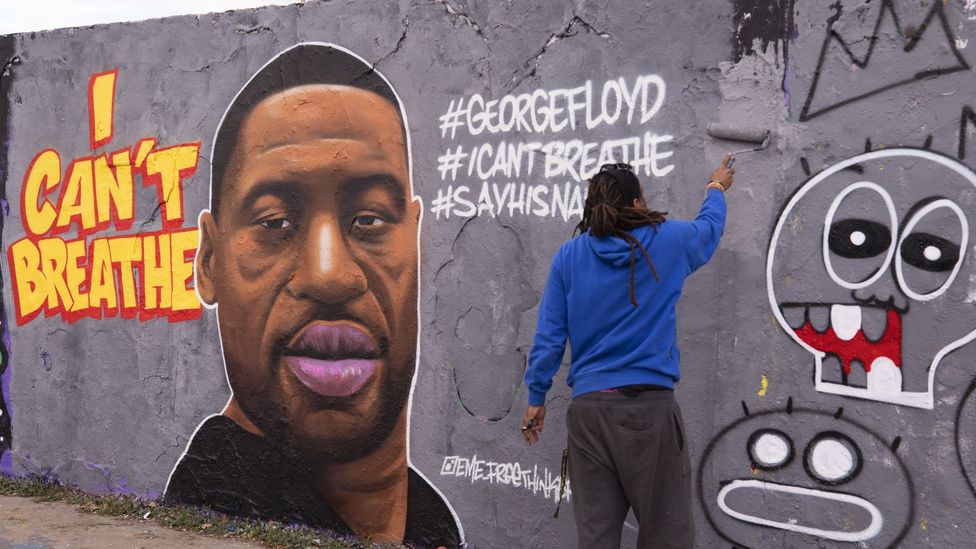
In Berlin’s Mauerpark, a mural by Dominic
“My thing is to inspire; once you’ve acknowledged the trauma, what do you do with it?” Dreph tells BBC Culture. “We are bombarded with negative imagery all day long; what do we do with that energy? It’s got to be moulded into something positive… I want to constantly make authentic, inspiring, meaningful, thought-provoking work, regardless of the context.”
I can go to pretty much any country in the world and meet a local within minutes because of the graffiti movement; it’s a network – Dreph
Dreph’s formative influences include New York’s hip-hop graffiti scene (“Our thing was to get our work in the most inaccessible and hard-to-reach places; that mindset is what I do with my work”) but also British comics such as 2000AD and Jamie Hewlett’s Tank Girl, as well as centuries of fine art, spanning Caravaggio to Jenny Saville. His painting style feels timely, and distinctly his own. In Britain, his street-portrait series includes Migrations, a celebration of multi-cultural local heroes – especially resonant around the Windrush scandal, where hundreds of Britons of Caribbean descent were wrongly threatened with deportation and refused vital services through the UK Government’s “hostile environment” policy.
Another is You Are Enough, which depicts an array of inspirational modern women. When we speak, Dreph has just completed a mural in Belfast, of the 18th-Century West African-born writer and abolitionist Olaudah Equiano, whose travels included a key period in Ireland; Equiano should surely be a fixture of school curriculums – but here, graffiti provides public education.
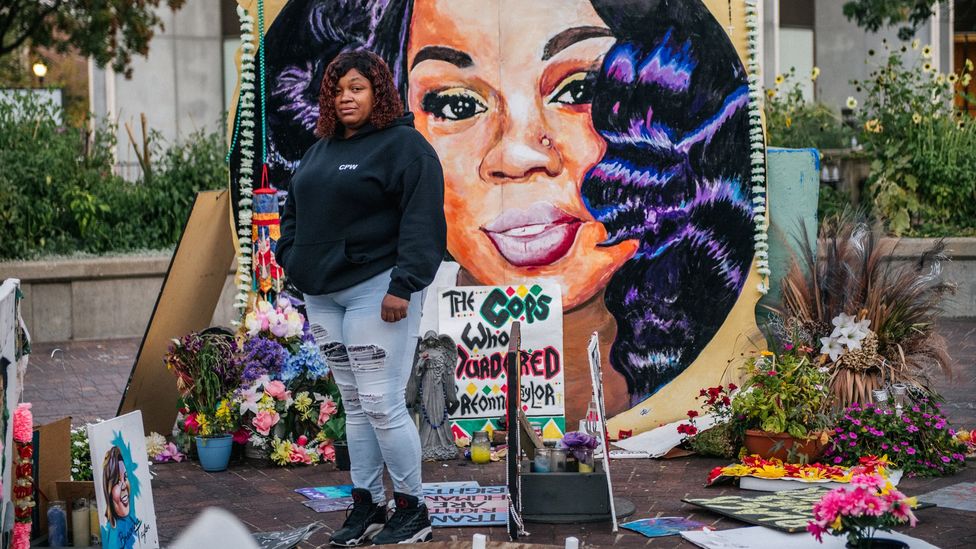
Tamika Palmer, the mother of Breonna T)
At its best, graffiti also evokes a sense of community – whether it’s the collaborative BLM pieces that have appeared internationally, or mass responses to individual works. “I realised early on that graffiti is a key, and I can go to pretty much any country in the world and meet a local within minutes because of the graffiti movement; it’s a network,” says Dreph. “With each place I visit, I’m learning and refining what I do. One aspect of my work, I’ve realised, is the community listening that happens,” he adds. “Say, for instance, I go to Brixton [a South London neighbourhood], and it takes me three days minimum to do my portraits. I’m there painting, and essentially giving something to a particular community that I don’t live in. After a day or two, I’m getting cups of tea, I’m getting told about local politics, about the gentrification of the area – all these different things by the locals that live there. The actual artwork that people see is only one aspect of it.”
Most of Dreph’s artworks now remain in place for a significant time; in summer 2020, one of them became a permanent feature of the outdoor set of the major British TV drama EastEnders: a radiant portrait (measuring 5m by 2m) of a young black woman.
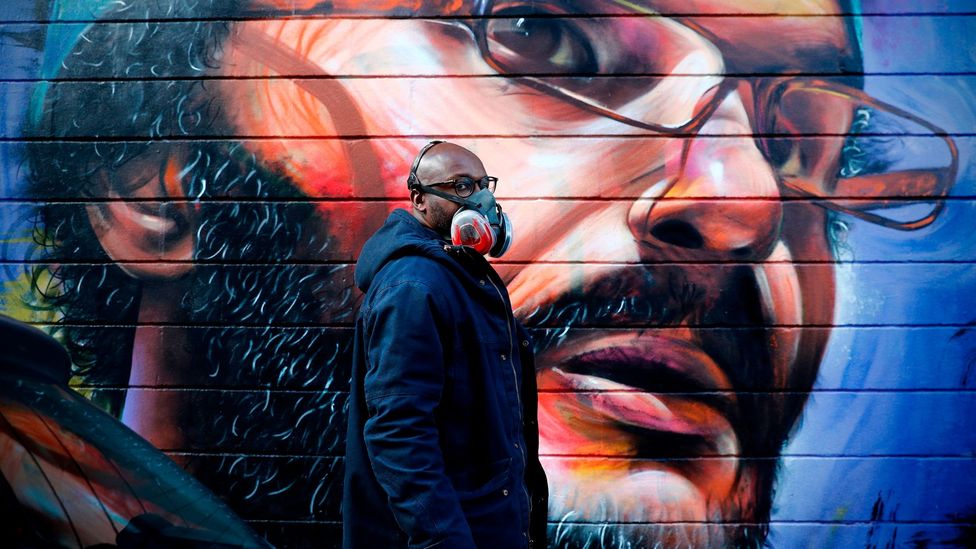
British-Ghanaian artist Dreph creates larg
“When I was asked to do the EastEnders job, they wanted to acknowledge an undeniable time,” says Dreph. “They wanted to do something meaningful, they wanted legacy. All of these words are the foundation of what I do; I was able to do that and nod to the time. They were adamant that they wanted something authentic, right down to making sure that my tag is very clear on the work.”
It’s fitting that such a pop culture phenomenon should display solidarity with BLM; it’s also an overdue reality check, given EastEnders’ London setting (as a life-long viewer, I couldn’t imagine this statement happening when the show started, 30 years ago). Graffiti communicates that spirit, across media, communities and continents; it brings vital remembrance, boundless diversity and indelible visibility.



